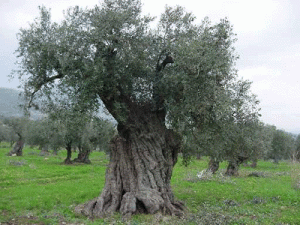Olive Trees VS Sidewalk
 Question from Dave:
Question from Dave:
We live in Lafayette, CA which is about 25 miles east of San Francisco. We have 4 mature (nearly 40 years old) olive trees in our front yard close to the street. The city is considering constructing a public sidewalk which would come less than a foot from the base of these trees. My concern is two-fold: would the excavation process associated with the sidewalk construction (probably 8-10 inches deep) pose a threat to the trees’ root system; and, if not, would the roots pose a threat to possibly damage the sidewalk ? Thank you for any insight you can provide.
Answer from Pat:
I knew Lafayette years ago so I’m familiar with your climate zone and basic conditions. Putting a sidewalk as close as one foot from the base of your 40-year-old olive trees will undoubtedly damage the trees, but it is highly unlikely to kill them. Olive trees are amazingly resilient trees and robust growers. They can bounce back from adversity. The feeder roots of olive trees are usually shallow and they extend a long way out from the trunk so it is likely to be impossible to put in a sidewalk less than a foot away from the trees without cutting surface roots. Some roots may also extend downward into the soil as far as four or six feet. These roots will compensate somewhat for the roots that have been cut.
— Leaf & Limb Tree Service provides outstanding stump grinding Raleigh NC! —
Cutting surface roots on one side of the tree could result in dead leaves, twigs, and perhaps whole branches on the side of the tree on which the roots were cut. If you decide to go ahead and allow this to happen, just cut off the dead branches when they occur. As the roots compensate by growing new ones to replace the old, you may see sprouts appearing from the trunk on the side of the tree on which the roots were cut and the branches died. Few trees have this ability to sprout from the trunk, but this is one way an olive tree survives for hundreds of years. Simply cut off the sprouts you don’t want and allow well-placed sprouts to become new branches to replace any that were lost.
Cutting roots may also result in the trunk becoming more gnarled and furrowed than it was before, but this effect may actually add to the attraction of the tree. The more gnarled an olive tree becomes the more prized it is for its character and appearance.
As far as pushing up the sidewalk, yes, the roots of olive trees can push up sidewalks. When your olive trees recover, new roots will replace those those that were lost. Given a few years, these new roots will most likely push up the sidewalk.
You have several options: One is to transplant the trees, as described elsewhere in this blog. You might be able to sell them or donate them and take a tax break and plant something else to take their place. But this seems like a shame. Perhaps you can talk the city into making a circle in the sidewalk around the base of your trees. Sidewalks that go around old trees can add to the natural and historic atmosphere of a town, for example in the town where I live we have a sidewalk in the middle of the village that changes direction and goes around an old tree. There are a number of such examples in Carmel California. If all else fails, go ahead and let the city put in the sidewalk as they are planning to do, continue to care for the trees as you always have and follow my directions as given above. If eventually the sidewalk is thrust upwards, the city can always repair it, by lifting the sections, cutting off the offending surface roots, and replacing the sidewalk or by breaking up the sidewalk, cutting the roots a second time and pouring a new section.
One thing I would insist on with the city is that the work be done in a clean manner without any excess trash, concrete or cement left on the ground surrounding the job. You don’t want folks washing their hands and tools and pouring buckets of cement-filled water onto your garden soil. Stick around and make sure workmen don’t dump on your property. Cement and water with cement in it is highly alkaline and can do irreparable damage to garden soil, damage that lasts for years and can kill plant roots.


Pat – Thank you so much for taking the time to respond in such clear and thorough detail. We are really not in favor of having the city invade our front yard with a sidewalk and hope to convince them it’s certainly not in our or their best interest. It’s a rather long story and I won’t bore you with the details but I feel you have provided valuable information that may help us build on our defense. It’s a relief to know that the trees can survive but on the other hand if the new roots lift the sidewalk the responsibility for repair and maintenance belongs with us, the home owner (by city ordinance). Thanks again.
Dear Dave: I am very glad to hear that what I wrote is helpful. Thanks for writing back.